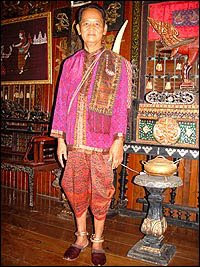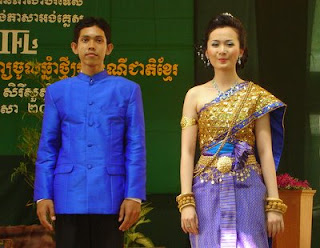In Khmer wedding, it has a lot of ceremonies held in chronological orders. They show the historical roots related to the Buddha’s period which existed ages ago. According to a book “Khmer Wedding Rules” of Oknha Nov, it puts that in ancient Khmer wedding laws, people perform a song describing God Vesandor Borom Pothisat arranging the marriage between his children – Chealy and Kroesna. And some other songs are about the marriage arrangement of God Ream and Seda. Oknha Nov wrote that the current wedding preparations are arranged according to the rules drawn up by King Preah Chey Chesda Thebdey.
According to the king’s book, it puts that all ceremonies in Khmer wedding are related to mythical stories such as a story “Som Sla Kanseng”. It is told that there were two men who went to feed their buffalos in the field would like to make friends with each other and wanted to be relative by marriage with each other because one had a son and the other had a daughter. In order to prove their words, they ask for betel nuts packed in krama from each other to show their promise that their children would marry to each other. Another story is “the three betel flowers”. It describes that there were four men who had different skills – swimming, shooting, fortune telling, and magic. After completing their study, they returned home. Along the way back near a stream, the fortune teller said that day they were going to meet a girl and become their wife. Then a big bird swooped down on a girl, Khemry, who was having a bath. Right away the shooting man took his bow and shot the bird down back to the stream. The swimmer then swam to bring her to the ground but she was just dead. After that the magic man helped her be alive again. All four men felt in love with the lad, so they were judged by the Buddha that she would become a wife of someone who swam to help her because he was able to touch her body first. And the fortune teller, magic man, and shooting man would become the father, mother, and brother respectively. Since then in all weddings, the bride and the groom must have three betel flowers in order to show gratitude towards their parents and brothers/sisters.
Setting-the-date ceremony and the groom holding the scarf are told that Prince Thaong was married to Princess Tevtey, a daughter of the sea dragon king. After setting the date already, Tevtey had to bring him to her father at dragon world, so the sea dragon’s daughter asked the prince to hold her scarf in order to dive into the dragon world. In the meanwhile, the dragon king commanded his man to kill the prince at the gate in order to test the prince’s ability. But the daughter had known this; hence, she disguised herself as the prince by changing her skirt and it was put on the prince instead so that the killer was not able to kill the prince. That is why in the current Khmer wedding it was seen that there is clothes change between the groom and the bride, and the groom holding the bride’s scarf in to the room, accompanied by “Phat Cheay and Neang Neak” songs, etc.
The ceremony called “Chey Haong Sousdey Haong Men Haong” in wedding ceremony performed until now is followed by an ancient story recorded in “the rules of wedding” book. It describes that Once upon a time there were two brothers – Chey and Sousdey. At that time, there was no king to continue after the previous king had died in Cambodia, so the officials in the palace relied on the holy elephant and horse to find a man to be their king. Then the animals approached the brothers’ house. Consequently, they knew that one of the brothers was the suitable man to be crowned. Chey became the king and Sousdey became his assistant at the same time. When crowned, the people whooped to bless the king. They said “Chey Haong Sousdey Haong Men Haong” simultaneously. The blessing is adapted to use in the wedding until now.
“Bongvil Popil” ceremony in the Khmer wedding is also written in “collective Khmer legends” book, volume 9. According to the legend, it is told that once upon a time, there was a man named Chey Sorya who had completed the magic training already from Eyso God, so he asked the God for a sacred relic as a blessing tool for the weddings of human being. Then the God gave the man a replica of his penis and a replica of his wife’s vagina as the blessing tools to spread their reputation in the world. Eyso God took diamond sand from the universe to make a gold banyan leaf representing his wife’s vagina and took a diamond rock from Himalaya Mountain to make a candle representing his penis and supposed them to be “two blessings”. He then told the man to take the candle wrapped in the banyan leaf to circle three times around grooms and brides in order to inhale the smoke making them powerful. The “Popil” ceremony is believed to bring harmony and joyfulness for the new couples making them successful in all challenges. Since Khmer people firmly and sincerely believe in “Popil”, it is performed not only in wedding ceremony but also in other ceremonies such as housewarming, birthday, etc.“holding a sword” tradition in the wedding progress is also told that once upon a time there was a high ranking knight in Peareansey Palace, who fell in love with a daughter of the villager and deposit a piece of gold as a dowry and promised to marry in three months’ time. Three years had gone, so she was married to her neighbor villager but on the wedding day, the knight appeared and took out his sword and killed the man who was the groom. Then the chief clergyman had prayed to dismiss all bad things at the place. The clergyman had analyzed on the power of the sword. That is why people use a sword in the wedding when the bride and the groom are in pair for blessing.
Tradition on Khmer Wedding SeasonWedding ceremony is very meaningful for each of individual’s life who follows their tradition and the laws of the country. That is why this ceremony is carefully dealt with concerning to choosing the date which is believed to bring luck and harmony for the people’s lives and starting a new families. Some families do not allow their children to marry in the rain season and some delay it for two years after the engagement ceremony because of the fortune telling.
According to Mr. Nhean Phoeun, a researcher and publisher of Khmer tradition of national and international festival committee, he said that Khmer tradition allows people to marry only in a period of six months in a year but not the other six. Wedding can be carried out only in the 30-day months. Those six months could be in early May, July, October, January, and March. But for engagement ceremony and matching the natural chemistry between son and daughter, they could be performed in any month.
He continued that for the above months, there are only 7 days of each month that are good days. According to the Khmer tradition, they should not perform on their birthday, religious day, lunar or and solar eclipse, and during Khmer new years.
Actually, the reason people do not get married in the rain season is that there are a lot of rains that make it difficult for the wedding reception, procession, and other ceremonies. It is also difficult for the guests travelling to wedding party and it is when farmers are busy with their fields.






 The lines of culture distinguishing one country from another are blurring. The globalization of technology, information and finance has allowed wealthy countries to export not only their political and economic ideologies to developing countries but their traditions and values as well.
The lines of culture distinguishing one country from another are blurring. The globalization of technology, information and finance has allowed wealthy countries to export not only their political and economic ideologies to developing countries but their traditions and values as well.

Join The Community